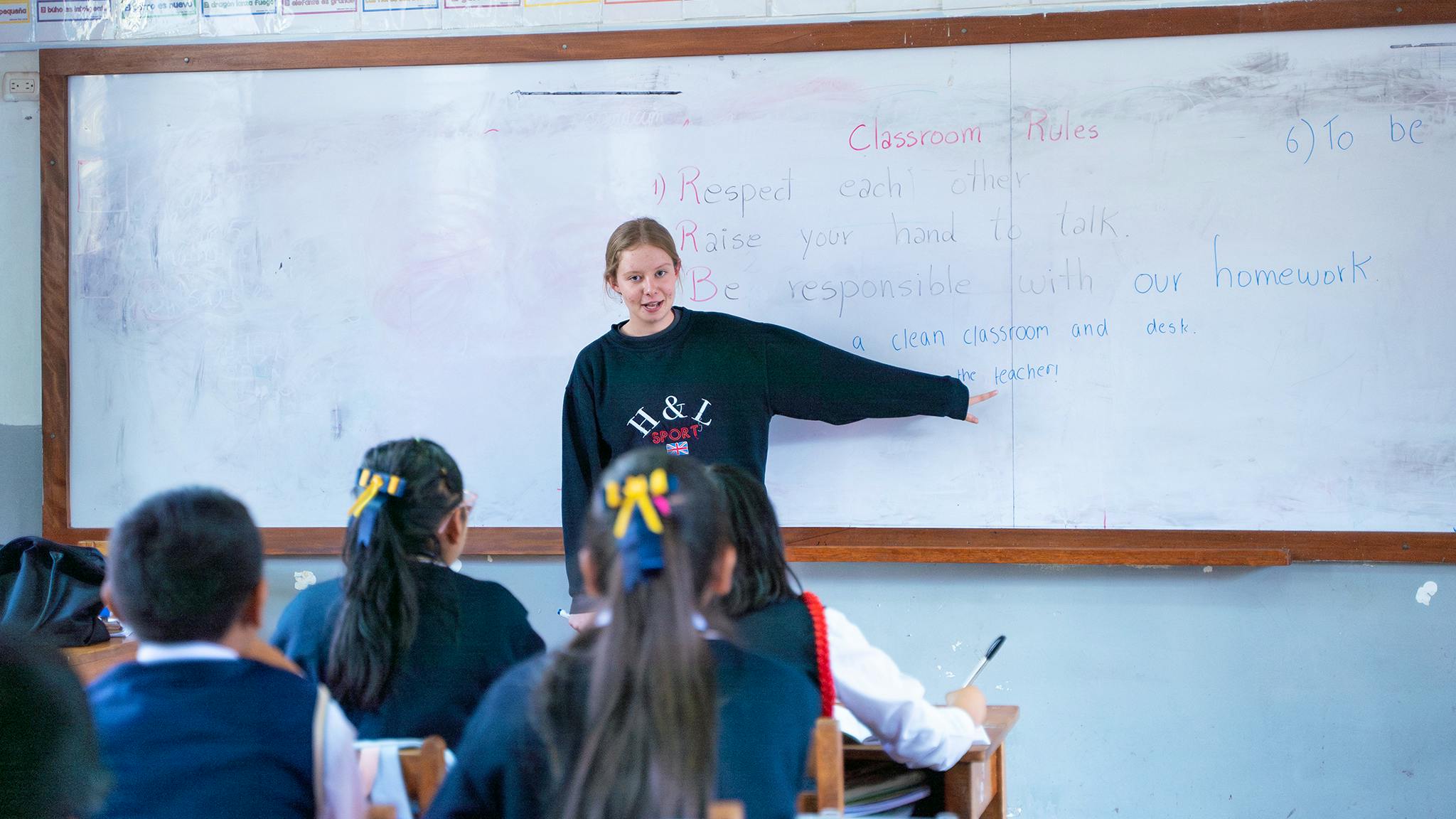As a volunteer teaching English in Peru, you will provide additional support to local teachers across the city of Cusco. Not only this, PMGY’s Peru volunteer programs provide a great foundation to improve your Spanish. The basic education and English learning focus provided in the Peruvian school system are not enough. Hence, volunteer support can make a big difference when participants decide to teach English in Peru.
BACKGROUND TO THE TEACHING PROGRAM
Peru isn’t one of the most advanced of the South American countries regarding the education system. Much of the Peruvian curriculum focuses on tradition and history. As a result, core areas including Maths, Science and communication are not widely understood at an appropriate level.
In Peru, there are three languages that are spoken including Spanish, Quechua and Aymara. The English language is very important in many regions of the country due to tourism. However, many of the educators are poorly trained and left responsible for oversized class sizes. As a result, the overall quality of education is poor.
Other contributions for lower levels of education may be the lifestyle of many families along with their economic status. In Peru, low-income families will require children to work in the evenings. Such work may involve selling items in the markets or collecting rubbish.
Children with higher-income families will have opportunities to study further and improve their levels of English. They can benefit from opportunities at specialised language schools and language institutions. Consequently, prospects improve and knowledge in areas such as sports, music and social activity increase.
In the 1970s, nearly 40% of the population only spoke the indigenous Quechua language. This resulted in high prejudice for anyone associated with rural work such as agriculture and maintenance. Over the decades, the importance of education has been on the rise due to the importance of social status. Slowly, the Quechua language has phased out providing an alarming reality of lost tradition.
Well educated people from both low and high-status families are provided with the opportunity to travel the country. This extends into opportunities to work internationally with tourism and trade along with governmental positions. As a result, many of the local people request that their children are given the opportunity to learn English.
Aside from receiving improved levels of education with a focus in English and Peruvian history, children are also introduced to recreational activities. Many of the local schools will provide sports and hygiene assistance to ensure their young generation is fit and presentable. For the reason that they will be well-rounded when the time comes to enter working society.
We have teamed up with local primary and secondary schools to ensure that children are given greater opportunities to learn English. Traditionally children in Peru don’t begin English classes until they are 12 years old when they enter secondary/high school. The earlier volunteers surround themselves with English, the better their prospects and learning opportunity will be.
Volunteer opportunities provided by PMGY offer a platform to make a positive impact when you teach English in Peru. When working at our volunteer teaching English abroad projects in Peru, it is important to maintain energy, enthusiasm and creativity. Many of these students will benefit from having someone who is fluent in the English language teaching them in Peru. As a volunteer teaching English in Peru, you will need to donate your time and skills effectively. This is to ensure you can maximise your impact on the local people. Finally, there are also a range of animal conservation volunteering projects in Peru you can support.
TEACHING VOLUNTEER PLACEMENT EXAMPLES
The Colegio Francisco Sirvichi - Established as a primary school, the Colegio Francisco Sirivichi separates into two periods of education. In the mornings the school offers an all-girls program for children 6-11 years old. The afternoons are co-ed courses providing for a more interactive learning environment for children 6-11 years old.
At both periods of the day, you will find 30-40 children per classroom. Therefore, volunteer support will come in very handy for the local staff! Each class has one to three instructors for general education and one teacher for English lessons. The English teacher will be teaching in the morning and afternoon to massive groups of children.
Due to the lack of assistance and resources for teaching, the English lessons are not applied appropriately. As a volunteer in the classroom, your role is to assist the teachers. This is done by supervising the children, improving English pronunciation, correcting exams and lesson planning.
Colegio Francisco Sirivichi also provides opportunities for children to get involved in sports. This can help reduce the strain on oversized classes for the English lessons. The sports lessons take place outside in a local field and within the normal curriculum. Volunteers can also assist with sports activities. Activities include supervising, helping with exercises and instructing new activities.
Please note that the project schedule at the school is split into two-timetables. The morning will require volunteers to join from 8am-1pm. The afternoon schedule is from 1pm-6pm. Thus, when you teach English in Peru at Colegio Francisco Sirvichi it is important to adopt a flexible working attitude.
The Colibri Afterschool Program - Created to support struggling parents, the Colibri afterschool program was developed to help working parents after their children are released from school. This project is an afterschool program organised by the Police Department of Cusco.
The mission of Colibri is to provide the children with a bright and promising future. This is achieved by educating and teaching them skills that will improve their prospects. Furthermore, the project structure encourages children to become more self-sufficient.
The Police Department organizes recreational activities, such as painting, dancing, drawing, etc. for the children that join this program. When the volunteers are present, they can organize these activities according to their skills.
The children are also often victims of domestic violence (emotional and physical) and abuse. Due to this, there is a high importance that the project has upbeat and patient volunteers! The project is especially rewarding for those that want to stay for longer periods of time. This is because they can develop deeper relationships with disadvantaged children.
The program will engage volunteers with children aged 5-15 years old. These children either work in the street or have mothers who work into the late evening. The project runs from 2pm-6pm on weekdays. Numbers can range greatly at this project from 15 children one day to 45 children the next day.
As a volunteer in Peru, you will organize and teach crafts, art, music or areas they have an interest in. The children will be taught English and assisted with homework. Volunteers are encouraged to provide lots of motivation and support at the Colibri project.
Colegio San Francisco de Borja - With a remarkable 399-year legacy, San Francisco de Borja is a historic public primary and secondary school. Known as the early educational ground of the revolutionary Tupac Amaru, it was once the sole school for the Inca royalty. Located just two blocks from Cusco’s main square, the school now serves 670 primary students across six grades and 720 secondary students across five grades. As a volunteer, you will assist the English teacher during the afternoons, working primarily with students aged 12 to 17. However, the schedule is not fixed and can change daily. Your role will involve supporting the teacher with lesson preparation, aiding students with grammar and pronunciation, and helping create a more engaging, enjoyable learning environment.
Your primary responsibilities include assisting with pronunciation and grammar exercises, designing creative activities to enhance language acquisition, and contributing ideas to make each lesson more dynamic and effective. Additionally, you’ll help evaluate quizzes and exams, track students’ progress, and provide constructive feedback to aid in their development. The regular schedule for this role is Monday to Friday, 1pm-6pm, though hours may vary depending on the English class schedule.
OTHER THINGS TO CONSIDER TEACHING CHILDREN IN PERU
Return Airport Transfer - Your return airport transfer is not included in your Program Fee. The most common method is to use a ridesharing app or private taxi service. Participants can often be travelling across their final few days and therefore are not necessarily heading back to the airport directly from our accommodation. The costs depend on your method of transport and your final destination. This can often be split across multiple participants if you are travelling with someone else on the program.
Experience - For the English Teaching program, teaching experience is not essential as the mere presence of a native English speaker is invaluable. As long as you are creative, determined and resourceful you can have a constructive impact on the development of the children’s education.
TEFL Course - We encourage volunteers to prepare as much as possible for their teaching program overseas. You can make the most out of your time by completing our convenient, inexpensive and international accredited 60 hour Online TEFL Course. The cost of this course is only 150 USD.
Resources - On the teach English in Peru project, resources can be very limited. Volunteers are recommended to bring materials to the project each day to maximise their productivity and day to day involvement. It is therefore important for volunteers to prepare well in advance to get the most out of their teaching English project experience.
Spanish Requirements - For the teaching program in Peru, we recommend that you speak a reasonable level of Spanish prior to your trip. There are no specific language requirements in order to join the program and you can join as an absolute beginner. However, we find that the ability to speak a good level of the Spanish language and a passion to learn more will greatly enhance your overall experience. This is because English is generally not widely spoken and therefore our programs should be viewed as a broader language immersion experience. If you do not speak a reasonable level of Spanish then you will find it difficult to communicate. As a result, this could lead to a more frustrating experience.
PMGY also offer Online Spanish Lessons that you can take before your trip. The lessons provide you with the opportunity to receive one-on-one classes from a trained Spanish teacher. Classes are held via Zoom and can be worked around your schedule back in your home country.
We also offer a learn Spanish in Peru program which you can take part in prior to your volunteer placement. This provides you with 20 hours-per-week of group Spanish lessons. Both of these options can be added during our online application process. They are highly recommended if you want to make the most of your volunteer placement.
Once you are in-country then you are also able to organise additional Spanish lessons directly with our local team. Volunteer feedback suggests that it can often be tiring to complete Spanish lessons at the same time as your volunteer programs in Peru. Consequently, we generally recommend extending your Language Immersion Program.
Project Commitment - For our childcare and teaching community projects we generally recommend where possible a minimum 4 week commitment from volunteers. This is so both the volunteer and project can maximise their experience.
We still have project availability for 2 and 3 week placement options where the placement benefits from volunteer support. However, such projects are usually limited to kindergartens for childcare and the afterschool project for English teaching. As a result, shorter-term volunteers will complete their volunteer work in such project settings accordingly.
Project Donation - With each volunteer, there is a donation made directly to the volunteer project you join us in Peru. This donation fee is included in the Program Fee you pay PMGY.
With that donation, the project is provided with increased financial support to improve resources, infrastructure and project environment. Such beneficiaries being the patients at the medical clinics, students at the schools, children at the kindergartens or the dogs at the dog shelter project.
Weekends - Your project work in Peru runs from Monday-Friday and weekends are free. You are welcome to relax and hang out at the volunteer accommodation but most participants will use this time to travel and explore the country. As a result, you can check out our Peru Weekend Travel Guide for top tips on how to spend your weekend. We also run two separate weekend trips which you can sign-up to before you depart for Peru. We offer the Lake Titicaca & Islands Trip along with the Machu Picchu Trip with opportunities running every month.
 ·
·
Verifisert av Volunteer World
·
·
·
Verifisert av Volunteer World
·

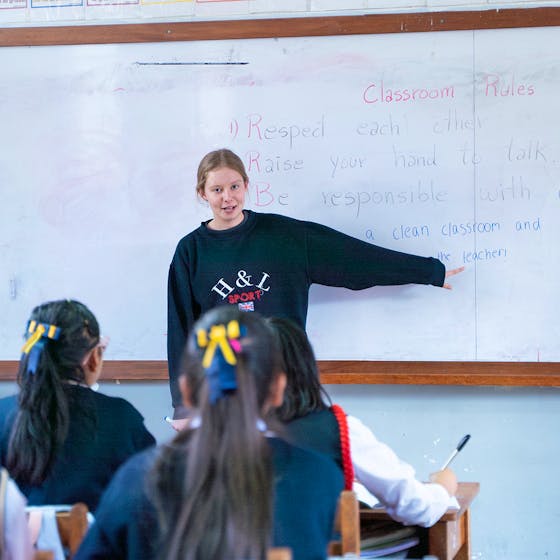
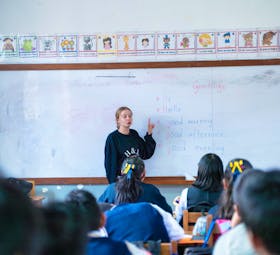
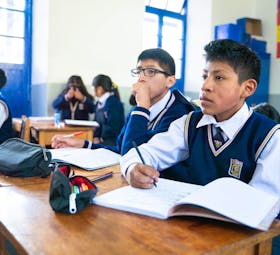
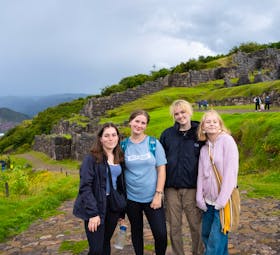
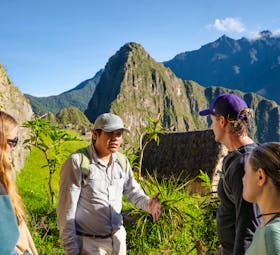

 (1434 gjennomganger)
(1434 gjennomganger)

 4.9
4.9

